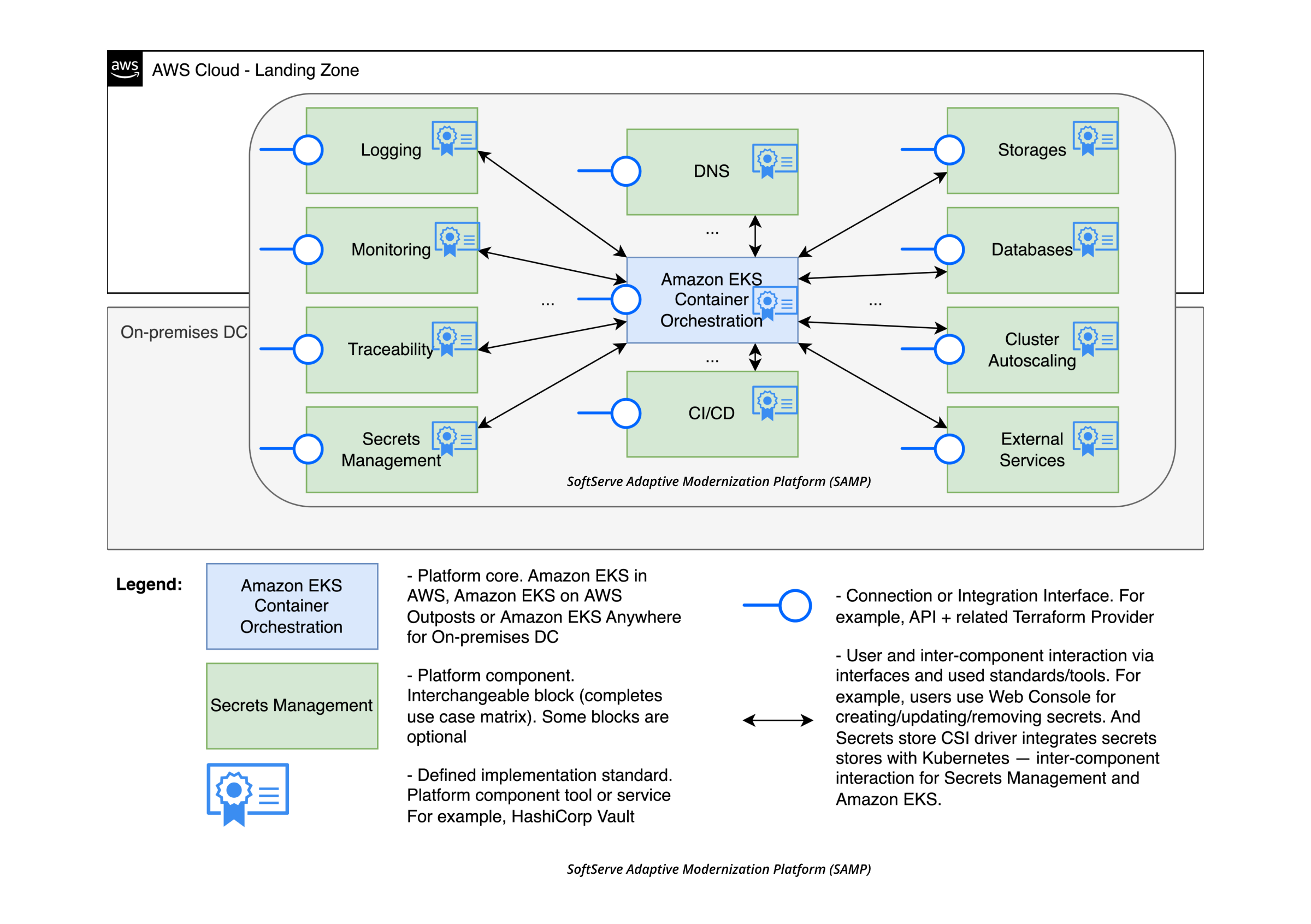
Don't want to miss a thing?
SoftServe Adaptive Modernization Platform-as-a-service: The Next Generation of Cloud Migration
Last updated: 04.08.2025
A staged cloud modernization lets your development teams focus solely on providing customers with top services in record time.
You know that innovation is the key to keeping up with evolving market demands and client needs. But good innovation is expensive and takes time. To avoid falling behind your competition and efficiently get ahead of the curve, you need to optimize your innovation — reducing product development costs and accelerating time to market.
You can achieve that with AWS Cloud. By requiring no significant investment in advance, AWS helps you kickstart your cloud-based acceleration. As soon as you’ve identified the business case for migrating to the cloud, you can get started.
However, cloud migration also presents challenges, and AWS Cloud is no exception. Rearchitecting and modernizing your workloads can be tricky. You need to set standards early on, and your team’s skills and internal processes may not be up to the task. Tackling this problem early on helps you maximize the ROI of your migration. So, the best way to adapt your processes and support your employees during your cloud migration is a staged AWS Cloud modernization with SoftServe.
Selecting your cloud modernization
How you structure your migration will depend on what you want to do with it. AWS provides three different models:
- Infrastructure-as-a-Service (IaaS) provides the highest level of flexibility and control over cloud resources. It’s easy to adopt and is similar to models that organizations use on-premises.
- Platform-as-a-Service (PaaS) eliminates the need for companies to manage their underlying cloud infrastructure. That frees them up to focus on the development, deployment, and management of organizational applications and services.
- Software-as-a-Service (SaaS) simplifies infrastructure management even further because AWS runs and manages the entire cloud infrastructure. Clients only need to pay attention to their own applications while using aspects of the SaaS.
If you are like most large companies, you’re probably interested in a hybrid combining aspects of all three models. The SaaS model provides reduced development and operational costs and innovation-readiness, while the IaaS model — and multiple components integrated in the PaaS model — offer flexibility and customization through component-level configuration tuning. Mixing different aspects of each of the three models means that your cloud journey will fit the exact needs of your business.
Every firm is unique, but they all face similar barriers to cloud adoption.
But if you lack the expertise to identify, select, and integrate the right components for your needs, you will need some assistance. It would all be a lot easier with an in-house platform for enterprises built on top of AWS Cloud, giving access to specific AWS services and third-party software.
That’s why we developed SoftServe’s App Modernization Platform.
Microservices and containerization: overcoming bias and dependency
In creating SoftServe Adaptive Modernization Platform (SAMP), our goal was to utilize a microservice architecture for loosely coupled and individually deployable applications. Inspired by AWS EKS Blueprints, we put AWS EKS at SAMP's core to run and scale Kubernetes workloads — aligning it with industry-standard techniques to orchestrate containerized applications. And thanks to containerization, development teams can work independently of one another — speeding up development and deployment time.

But containerization is not enough. Without cross-team (organization-wide) standards, each development team will decide how they want to collect logs and metrics from applications, handle secrets, scale pods, and use persistent storage. But letting local teams set standards allows developers’ bias and inexperience to play a role.
So, instead of reduced time to market and higher ROI, you could see delays in service development, on top of extra costs and missing components. That’s why SAMP has multiple default platform components with fully automated setup that takes about 18 minutes — giving you unified functionality right out of the box.
SAMP gives you an auditable, extendable, and customizable platform with cross-team standards.
SAMP also enables your teams to select extra components, defined as interchangeable blocks, letting your developers easily add platform components according to their needs. Each component has a predefined integration interface. So, based on those integration interfaces, as well as your experience, we can define a tool or service to implement a given component as a block — for example, HashiCorp Vault to manage secrets. Once you have selected your components, your teams can quickly deploy and run their applications with a built-in application onboarding checklist.
Simplified workflows and accelerated development
With SAMP, your team can concentrate on product development, not setting standards. You won’t have to spend months reviewing new services, running multiple POCs, defining new standards, and adding missing components.
Don’t waste time continuously redefining standards — SAMP gets your apps to market 20 times faster.
Simplified workflows help you adapt to global demand and reach customers — boosting ROI through efficient cost controls. Just how much your ROI will increase depends on the degree of customization and the maturity of your current container strategy.
If you want to learn more about why SAMP is right for you — or start building a personalized container strategy from scratch — get started with a Container Strategy Assessment.
And stay tuned for a detailed description of the Containers Maturity Assessment Pack and the Containers Maturity Assessment Tool we built for it.

